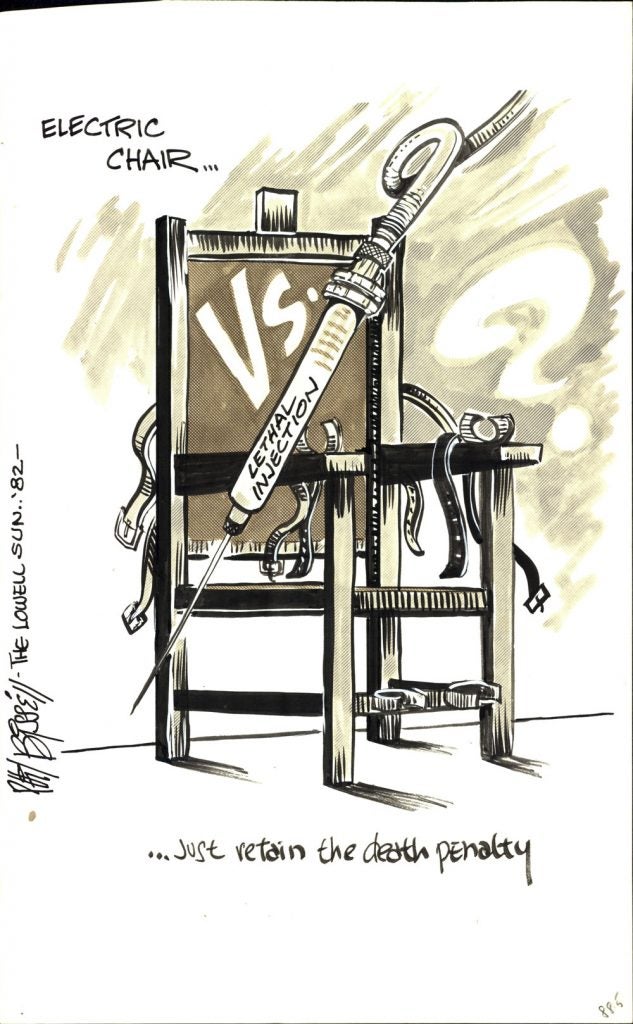
“Ladies Day” (July 15, 1952)
by Burris A. Jenkins, Jr. (1897-1966)
14 x 20, ink and wash on board
Coppola Collection
Burris Jenkins Jr. was the son of a prominent Kansas City minister, war correspondent and newspaper editor. Jenkins Jr. was a popular sports cartoonist, whose work appeared in the New York Journal-American from 1931. His humorous published verses were also popular. Although best known for his sports themes, Jenkins was also a skilled courtroom illustrator and editorial cartoonist.
Jenkins was not afraid to provoke, and he has some strong WW2 examples, including one of the rare direct commentaries on concentration (death) camps. Among his best-remembered cartoons are his angry piece on the discovery of the dead Lindbergh baby, and his sentimental image of Babe Ruth’s farewell to Yankee Stadium.
He was fired from his first job at the Kansas City Post for a series of pessimistic Christmas cartoons, a firing that prompted his father’s resignation from the same newspaper.
His father was an interesting guy. Jenkins, Sr (1968-1945) was ordained in 1891 and served as a pastor in Indianapolis. He received advanced degrees from Harvard and went on to serve as a professor and president of the University of Indianapolis and president of Kentucky University. He left Kentucky to return to Kansas City as pastor of the Linwood Boulevard Christian Church. The church burned in 1939, and Jenkins chose Frank Lloyd Wright as the architect for the church’s new home overlooking the Country Club Plaza.
Jenkins served as editor of the Kansas City Post from 1919 to 1921, hoping to fight for the establishment of the League of Nations. The Jenkins, Sr., biography tells the story about his leaving the Post slightly differently that for the son: “After two years, it became necessary for him to choose between the newspaper and his pulpit and, without hesitation, he resigned from the Post.”
“Live dangerously!” Jenkins would thunder from the pulpit, embracing his own philosophy against all adversaries. Unconventional in nearly every aspect of his chosen field, Jenkins often preached from non-Biblical texts, such as the latest book or his travels abroad. The church frequently hosted motion pictures, dances, card games, and fundraising boxing matches. These activities led to opposition to Jenkins and his Community Church from other churches in the city.
The concept of a “Ladies Day” at traditionally male dominated events, particularly sporting events, was widespread in the post-WW2 era, as the rise in numbers of women as independent consumers grew.
From the 1920s through the 1950s, older women were members of a generation that still sometimes associated the prerogative of voting with male citizenship. Prior to 1920, anti-suffrage groups had drawn both men and women to their ranks in an effort to “protect the home.” Thus, it is not surprising that (especially) some older women did not choose to vote once the Nineteenth Amendment was ratified.
Women were slow to use their new voting privilege. This is typical of any newly enfranchised group.
Of the 1952 election, Louis Harris commented: “It raises the real possibility that in the future there will be a ‘woman’s vote’ quite separate from the men’s”
The Eisenhower campaign was one of the first presidential campaigns to make a major, concerted effort to win the female vote. Many of his radio and television commercials discussed topics such as education, inflation, ending the war in Korea, and other issues that were thought to appeal to women. The Eisenhower campaign made extensive use of female campaign workers. These workers made phone calls to likely Eisenhower voters, distributed “Ike” buttons and leaflets, and threw parties to build support for the GOP ticket in their neighborhoods. On election day, Eisenhower won a solid majority of the female vote.
Eisenhower campaigned by attacking “Korea, Communism, and Corruption”—that is, what the Republicans regarded as the failures of the outgoing Truman administration to deal with these issues.
Here, following the Republican Convention of 1952, a emerging notion of “Ladies Day” in a voting bloc, even if the oh-so-stereotypical “uprising housewife,” angry with men and going after them with her rolling pin, is still the prevailing image.

















